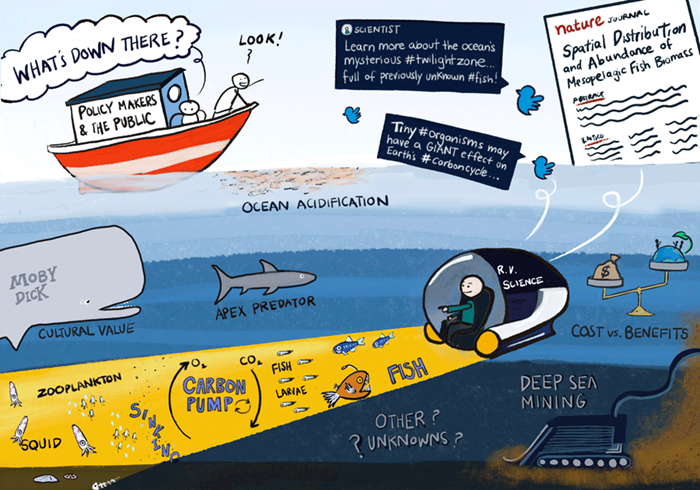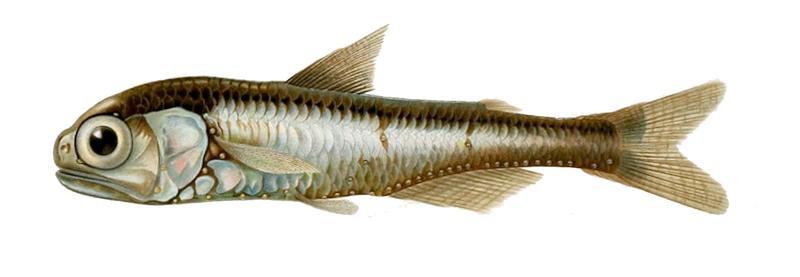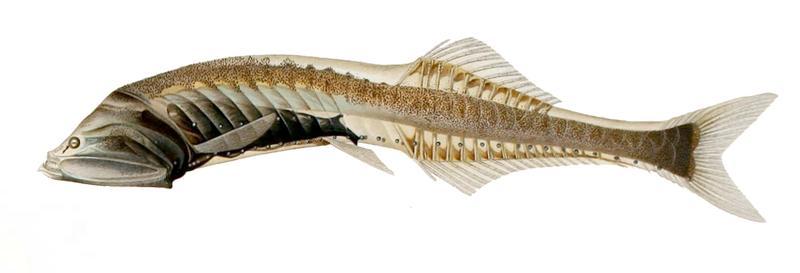Democratizing the governance of the deep sea

Figure 1. A graphical summary of 'Science governs the future of mesopelagic zone' (Schdeberg, A.,Kraan, M.,Groeneveld, R.et al. 2023).
The deep sea is among the least accessible ecosystems on Earth. However, thanks to technology allowing humans and robots to go further and deeper, more and more people are gaining some idea of what parts of the deep seabed look like and what lives there. But the biggest part of the deep sea is the vast volume of open water between 200 and 1,000 metres depth, known to scientists as the mesopelagic zone.
This unexplored part of our planet is home to abundant and diverse life. The deep-sea fisheries of the mesopelagic zone are unlikely to remain unexploited, raising many questions. The first ones are practical: how many of these fish are there? Where do they live? How do they reproduce? Are they nutritious? However, in addition, there are many political questions: who will decide about the trade-offs between exploitation and conservation, on what basis will these decisions be made, and who will benefit? And on this dark, blank canvas, is there a chance to get marine environmental management right?
Science governs the future of the mesopelagic zone
The mesopelagic zone is, therefore, a new frontier for both the research and the fishing industries. How will management evolve and who will shape public discourse on a realm that has no descriptive or narrative precedent? Amanda Schadeberg and her colleagues wanted to know who was talking about the mesopelagic zone and what they were saying. Using a computational methodology, they analysed 2,226 scientific abstracts and 4,066 Tweets about the mesopelagic zone, identifying the most important topics across expert and public domains of communication[1].
The conversation about the mesopelagic zone in the literature and on X boiled down to two (perhaps unsurprising) themes: fish (their abundance, distribution, and life cycles) and carbon (see Box). This enormous ecosystem is, therefore, being understood in terms of its capacity to support fish stocks and its role as a carbon sink. While the research team had expected X to be a place for alternative ideas about the deep ocean, that digital space turned out to be almost exclusively occupied by scientists and their funding bodies. To their surprise, Schadeberg and her colleagues also found no mention of the mesopelagic zone in major ocean policy documents. Taken together, the authors conclude that the characteristics and uses of the mesopelagic zone are being negotiated in the scientific domain, long before being communicated to the public or governed by legally recognized policies (see Fig. 1). That means that the future of one of the largest ecosystems on Earth is presently being shaped by a very small group of people.
opportunities to supply food for farmed salmon[3]. Meanwhile, NGOs are calling for a highly precautionary approach, if not a moratorium, to protect mesopelagic fish.
From scientific governance to democratization, transparency, and accountability
This—as yet—unexploited space reverberates with possibilities: how democratic and inclusive can we be in the management of the deep ocean? Schadeberg and colleagues propose that it would be beneficial to move beyond a use-based narrative of food security vs carbon sequestration services—largely driven by scientists in the global north—to a more inclusive model of decision-making.
But how could governance of the deep sea be democratized?
How can we encourage conversations about who and what the deep sea is for? And why should people care anyway? The authors see three possible routes to improve mesopelagic zone governance: Firstly, the decision-making processes and logics of existing science-based governance organizations like regional fisheries management organizations and the International Seabed Authority (ISA) should become more transparent and publicly accountable. The scientists that inform these organizations have a responsibility to engage with diverse publics during their work. Secondly, ocean citizens should be included in dynamic ocean management through open digital platforms like Global Fishing Watch. Collaborations with artists and ethicists can also work to stimulate the realm of imagination so that people have alternative ways to relate to the deep sea and form an emotional connection with it. Thirdly, wider participation in deep-sea governance can be facilitated by an emerging unified global ocean governance infrastructure that would bring together data in a standardized way. Elements of this infrastructure already exist; for example, the Global Ocean Observing System. The new UN High Seas Treaty could provide a mandate for its development, but the challenge would lie in making it accessible for diverse ocean citizens with different values and forms of knowledge.
The fate of the clear, dark waters of the mesopelagic zone hangs in the balance. If it is to achieve sustainable exploitation and deliver fair and equitable outcomes, ocean governance must be much more inclusive. By reaching hearts and minds on land (as well as fish and carbon in the deep), marine science can contribute to an improved model of decision-making about the future of the mesopelagic zone. •
- Amanda Schadeberg (amanda.schadeberg@wur.nl) and Guy Baker
Further reading
Schadeburg, A., Kraan, M., Groeneveld, R. et al. 2023. Science governs the future of the mesopelagic zone. npj Ocean Sustain 2: 2. https://doi.org/10.1038/s44183-023-00008-8
Box - Pumping carbon: the role of the most abundant vertebrates on Earth
The mesopelagic zone is home to enormous numbers of small fish, mostly lanternfish (254 species in the order mycophiforms)[4] and bristlemouths. Lanternfish range from 2 to 30 cm in size and get their name from bioluminescent spots or photophores, which are thought to help them identify and communicate with their own kind. Billions of lanternfish migrate to surface waters at night to feed on zooplankton, returning to depth during the day to avoid predators and to defecate. In thie way, carbon is 'pumped' downwards to deep water.
Bristlemouths are mostly under 5 cm in length. They are also bioluminescent, but remain in deep water waiting for food to drift down to them. They are even more numerous than lanternfish and are thought to be the most abundant vertebrate on Earth[5]
Estimates in the literature for all mesopelagic fish range from 2.4 gigatons (Anderson 2019) to a maximum of 19.5 Gt (Irigoien 2014)[6]. The most reported figure is 10 Gt from Irigoien et al. (2014). Given these mind-boggling numbers, it is vital to find out how much these fish contribute to the carbon cycle and how they may be impacted by climate change.
1 cm


Above. An illustration of (top) a type of lanterfish (Myctophum punctatum) and (bottom), a type of bristlemouth (Cyclothone microdon). Emma Kissling, Public domain, via Wikimedia Commons.
[4] Dipper, F. 2016. The Marine World. Wild Nature Press
[5] Irigoien, X., Klevjer, T., Røstad, A. et al. 2014. Large mesopelagic fishes biomass and trophic efficiency in the open ocean. Nature Communications, 5: 3271. https://doi.org/10.1038/ncomms42716 https://www.nature.com/ articles/ncomms4271
[1] All tweets made before 31 December 2020 on the social media platform Twitter before it became X.
[2] https://summerh2020.eu/about-summerh2020/
[3] Sadik-Zada, E.R.; Ferrari, M.; Gonzalez, A.; Yusubova, L. 2023. Could deep-sea fisheries contribute to the food security of our planet? Pros and cons. Sustainability, 15: 14778/ http://doi.org/10.3390/su152014778
